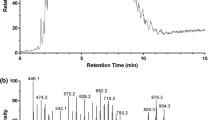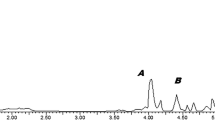Abstract
The qualitative and quantitative composition of the principal lipid constituents of Siberian musk deer (Moschus moschiferus) preputial gland secretion, main odor carriers and potential precursors of odorous substances, was investigated by means of high-performance liquid chromatography. Free fatty acids and phenols (10%), waxes (38%), and steroids (38%) were found to be the main groups of the secretion lipids. Cholestanol (I), cholesterol (II), androsterone (III), Δ4-3α-hydroxy-17-ketoandrostene (IV), 5β, 3α-hydroxy-17-ketoandrostane (V), 5α, 3β, 17α-dihydroxyandrostane (VI), 5β, 3α, 17β-dihydroxyandrostane (VII), and 5β, 3α, 17α-dihydroxyandrostane (VIII) were isolated from the steroid fraction and their structures confirmed by IR, PMR, and mass spectra. 3-Methylpentadecanone (muscone) was not identified among the secretion lipids. Preputial gland secretion stimulated sex behavior of musk deer females.
Similar content being viewed by others
References
Bakke, J.M., andFigenschow, E. 1983, Volatile compounds from the red deer (Cervus elaphus). Secretion from the tail gland.J. Chem. Ecol. 9:513–520.
Cherkasov, A.A. 1884. Zapiski ohotnica Vostochnoy Sibiri, 2nd ed. St. Petersburg (in Russian).
Do, J.C., Kitatsuji, E., andYoshii, E. 1975. Study on the components of musk. I. Ether soluble components.Chem. Pharm. Bull. 23:629–635.
Flerov, K.K. 1952. Kabargi i oleni. Moscow-Leningrad, pp. 25–58 (in Russian).
Honachi, J.H., Kinman, K.E., andKoeppl, J.M. (eds.). 1982. Mammal Species of the World. Allen Press, Lawrence, Kansas.
Kates, M. 1972. Techniques of Lipidology. American Elsevier, New York.
Lin, J.-T., andHeftmann, E. 1982. Comparison of adsorption and reversed-phase partition HPLC for the separation of androgens.J. Chromatogr. 237:215–224.
Mookherjee, B.D., andLedig, W.R. 1970. Unpublished results; see pp. 437–438,in E.T. Theimer (ed.). 1982. Frangrance Chemistry. The Science of the Sense of Smell. Academic Press, New York.
Mookherjee, B.D., andWilson, R.A. 1982. The chemistry and fragrance of natural musk compounds, pp. 433–494,in E.T. Theimer (ed.). Fragrance Chemistry. The Science of the Sense of Smell. Academic Press, New York.
Nambara, T., andTakahashi, H. 1970. Analytical chemical studies of steroids. XLI. Metabolism of 3-deoxysteroids. VI. Isolation and characterization of urinary metabolites of 3-deoxyde-hydroepiandrosterone in the rabbit.Chem. Pharm. Bull. 18:2309–2313.
Ohloff, G., Maurer, B., Winter, B., andGiersch, W. 1983. Structural and configurational dependence of the sensory process in steroids.Helv. Chim. Acta 66:192–217.
Paradisi, M.P., Zeccini, G.P., andRomeo, A. 1977. Selective reduction of steroidal diketones with poly(N-alkyliminoalanes).Tetrahedron Lett. 27:2369–2372.
Reed, H.C.B., Melrose, D.R., andPatterson, R.L.S. 1974. Androgen steroids as an aid to the detection of estrus in pig artificial insemination.Br. Vet. J. 130:61–67.
Ruzicka, L. 1926, Zur Kenntnis des Kohlenstoffringes VII. Über die Konstitution des Muscones.Helv. Chim. Acta 9:715–729.Chem. Abstr. 21:571.
Schinz, H., Ruzicka, L., Geyer, U., andPrelog, V. 1946. Muscopyridin, eine Base C16H25N aus, naturlichen Moschus.Helv. Chim. Acta. 29:1524–1528.
Shaposhnikov, F.D. 1956. Materiali k ekologii kabargi Severo-Vostochnogo Altaya. Zool. Zh. 35:1084–1093 (in Russian).
Schabron, J.G., Hurtubise, R.H., andSilver, H.F. 1979. Chromatograhic and spectrophotometric methods for separation, characterization and identification of alkylphenols in coal-derived solvents.Anal Chem. 51:1426–1433.
Sokolov, V. 1982. Mammal Skin. University of California Press, Berkeley.
Sunde, A., andLindmo, P.I. 1982. Separation of 5α-reduced androgens by RP HPLC.J. Chromatogr. 242:381–384.
Tarasov, P.P. 1960. O biologicheskom znachenii pachuchih zelez u mlekopitaushih.Zool. Zh. 39:1062–1068 (in Russian).
Wang, J.-L., andHuang, H.-M. 1980. Effect of male hormones on musk secretion by musk deer.Chung Ts'ao Yao 11:178–179.Chem. Abstr. 93:180102.
Williams, D.H., andBhacca, N.S. 1964. Dependency of vicinal coupling constants on the configuration of electronegative substituents.J. Am. Chem. Soc. 86:2742–2743.
Yu, D., andDas, B.C. 1983. Structure of hydroxymuscopyridine A and hydroxymuscopyridine B, two new constituents of musk.Planta Med. 49:183–184.
Author information
Authors and Affiliations
Rights and permissions
About this article
Cite this article
Sokolov, V.E., Kagan, M.Z., Vasilieva, V.S. et al. Musk deer (Moschus moschiferus): Reinvestigation of main lipid components from preputial gland secretion. J Chem Ecol 13, 71–83 (1987). https://doi.org/10.1007/BF01020352
Received:
Accepted:
Issue Date:
DOI: https://doi.org/10.1007/BF01020352




